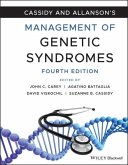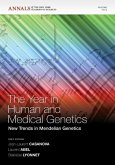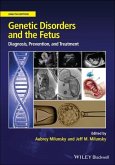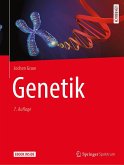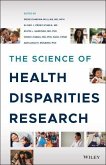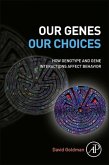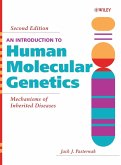Pain Genetics
Basic to Translational Science
Herausgegeben von Belfer, Inna; Diatchenko, Luda
Pain Genetics
Basic to Translational Science
Herausgegeben von Belfer, Inna; Diatchenko, Luda
- Gebundenes Buch
- Merkliste
- Auf die Merkliste
- Bewerten Bewerten
- Teilen
- Produkt teilen
- Produkterinnerung
- Produkterinnerung
Pain Genetics: Basic to Translational Science is a timely synthesis of the key areas of research informing our understanding of the genetic basis of pain. The book opens with foundational information on basic genetic mechanisms underlying pain perception and progresses recently discovered complex concepts facing the field. The coverage is wide-ranging and will serves as an excellent entry point into understating the genetics of pain as well as providing a single resource for established researchers looking for a better understanding of the diverse strands of research going on in the…mehr
Andere Kunden interessierten sich auch für
![Cassidy and Allanson's Management of Genetic Syndromes Cassidy and Allanson's Management of Genetic Syndromes]() Cassidy and Allanson's Management of Genetic Syndromes280,99 €
Cassidy and Allanson's Management of Genetic Syndromes280,99 €![The Year in Human and Medical Genetics The Year in Human and Medical Genetics]() The Year in Human and Medical Genetics158,99 €
The Year in Human and Medical Genetics158,99 €![Genetic Disorders and the Fetus Genetic Disorders and the Fetus]() Genetic Disorders and the Fetus340,99 €
Genetic Disorders and the Fetus340,99 €![Genetik Genetik]() Jochen GrawGenetik74,98 €
Jochen GrawGenetik74,98 €![The Science of Health Disparities Research The Science of Health Disparities Research]() The Science of Health Disparities Research224,99 €
The Science of Health Disparities Research224,99 €![Our Genes, Our Choices Our Genes, Our Choices]() David GoldmanOur Genes, Our Choices82,99 €
David GoldmanOur Genes, Our Choices82,99 €![An Introduction to Human Molecular Genetics An Introduction to Human Molecular Genetics]() Pasternak, Jack, K.An Introduction to Human Molecular Genetics190,99 €
Pasternak, Jack, K.An Introduction to Human Molecular Genetics190,99 €-
-
-
Pain Genetics: Basic to Translational Science is a timely synthesis of the key areas of research informing our understanding of the genetic basis of pain. The book opens with foundational information on basic genetic mechanisms underlying pain perception and progresses recently discovered complex concepts facing the field. The coverage is wide-ranging and will serves as an excellent entry point into understating the genetics of pain as well as providing a single resource for established researchers looking for a better understanding of the diverse strands of research going on in the area.
With contributors painstakingly selected to provide a broad range of perspectives and research, Pain Genetics will be a valuable resource for geneticists, neuroscientists, and biomedical professionals alike.
Hinweis: Dieser Artikel kann nur an eine deutsche Lieferadresse ausgeliefert werden.
With contributors painstakingly selected to provide a broad range of perspectives and research, Pain Genetics will be a valuable resource for geneticists, neuroscientists, and biomedical professionals alike.
Hinweis: Dieser Artikel kann nur an eine deutsche Lieferadresse ausgeliefert werden.
Produktdetails
- Produktdetails
- Verlag: Wiley & Sons
- 1. Auflage
- Seitenzahl: 204
- Erscheinungstermin: 3. Februar 2014
- Englisch
- Abmessung: 246mm x 172mm x 17mm
- Gewicht: 522g
- ISBN-13: 9781118398845
- ISBN-10: 111839884X
- Artikelnr.: 39178856
- Herstellerkennzeichnung
- Libri GmbH
- Europaallee 1
- 36244 Bad Hersfeld
- gpsr@libri.de
- Verlag: Wiley & Sons
- 1. Auflage
- Seitenzahl: 204
- Erscheinungstermin: 3. Februar 2014
- Englisch
- Abmessung: 246mm x 172mm x 17mm
- Gewicht: 522g
- ISBN-13: 9781118398845
- ISBN-10: 111839884X
- Artikelnr.: 39178856
- Herstellerkennzeichnung
- Libri GmbH
- Europaallee 1
- 36244 Bad Hersfeld
- gpsr@libri.de
Inna Belfer, MD, PhD, is an Associate Professor of Anesthesiology and Human Genetics and Director of the Molecular Epidemiology of Pain Program at the Department of Anesthesiology, School of Medicine, University of Pittsburgh. Luda Diatchenko, MD, PhD, is a Canada Excellence Research Chair in Human Pain Genetics, Professor, Faculty of Medicine, Department of Anesthesia, and Faculty of Dentistry at McGill University, Alan Edwards Centre for Research on Pain.
Editors' Biographies xi
Contributors xiii
1 How Do Pain Genes Affect Pain Experience? 1
Marshall Devor
Introduction 2
Heritability of Pain: Historical Roots 2
Why is Pain Genetics Interesting and Potentially Useful? 4
What Are Pain Genes? 8
How Do Pain Genes Affect Pain Experience? 9
Disease Susceptibility Genes Versus Pain Susceptibility Genes 12
Perspective 13
Acknowledgments 13
2 Conservation of Pain Genes Across Evolution 15
Thang Manh Khuong and G. Greg Neely
Introduction 15
Anatomical Organization of Nociception Apparatus in Mammals and Drosophila
16
Acute Heat Pain in Mammals 16
Acute Heat Nociception in Drosophila 18
Mechanical Pain in Mammals 19
Mechanical Nociception in Drosophila 19
Chemical Nociception in Mammals 21
Chemical Nociception in Drosophila 21
Inflammatory Pain in Mammals 22
Persistent Pain in Drosophila 22
Neuropathic Pain in Mammals 25
Structural Reorganizations of Nerve Fibers in Neuropathic Pain 25
Mammalian Neuropathic Pain Genes That Are Conserved in Drosophila 25
Long-Term Potentiation and Long-Term Depression in Neuropathic Pain in
Mammals 28
Neuropathic Pain in Drosophila 30
Conclusions 30
3 Defining Human Pain Phenotypes for Genetic Association Studies 37
Christopher Sivert Nielsen
Introduction 37
What is a Pain Phenotype? 38
Pain Scaling 39
Heritability 40
Genotype-Phenotype Matching 41
Reliability and Temporal Stability 41
Clinical Phenotypes 43
Designing Clinical Pain Genetic Studies 43
The Heritability of Specific Clinical Pain Conditions 45
Experimental Phenotypes 45
The Heritability of Experimental Phenotypes 46
Extended Phenotypes 47
Practical Concerns 47
Conclusions 48
Conflict of Interest Statement 48
4 Genetic Contributions to Pain and Analgesia: Interactions with Sex and
Stress 51
Roger B. Fillingim and Jeffrey S. Mogil
Introduction 51
Brief Overview of Sex and Gender Differences in Pain and Analgesia 52
Brief Overview of Stress and Pain/Analgesia 52
Sex X Gene Interactions in Pain and Analgesia 53
Summary 57
5 Abnormal Pain Conditions in Humans Related to Genetic Mutations 61
Christopher Geoffrey Woods
Introduction to SCN9A, NTRK1, and NGF and the Roles They Play in Pain 61
Introduction to SCN9A and Its Omnipotent Role in Pain Sensing 62
Introduction to NTRK1 and Its Role in Development and Function in the Pain
and Sympathetic Nervous Systems 69
Introduction to NGF, the First Nerve Growth Factor to Be Found and Studied
72
6 Alternative Pre-mRNA Splicing of Mu Opioid Receptor Gene: Molecular
Mechanisms Underlying the Complex Actions of Mu Opioids 79
Ying-Xian Pan
Introduction 79
Evolution of OPRM1 Gene 80
OPRM1 Gene: Chromosomal Location and Gene Structure 82
Alternative Promoters 82
Alternative Pre-mRNA Splicing of the OPRM1 Gene 83
Expression and Function of the OPRM1 Splice Variants 90
Conclusion 94
7 Discovering Multilocus Associations with Complex Pain Phenotypes 99
Chia-Ling Kuo, Luda Diatchenko, and Dmitri Zaykin
Introduction 99
Approaches Based on Testing Individual Genetic Variants Within a Region 100
Approaches That Combine Association Signals Across Genetic Variants 101
Methods for Testing Joint Effects of Multiple Genetic Variants 102
Multilocus Analysis of Mu Opioid Receptor Haplotypes 103
Two-Stage Multilocus Association Analysis: Collapsing SNPs with Adjustment
for Effect Directions 104
Two-Stage Approach: Simulations 107
Two-Stage Approach: Results 108
Discussion 111
Acknowledgments 113
8 Overlapping Phenotypes: Genetic Contribution to Nausea and Pain 115
Charles C. Horn
Introduction 115
What is the Functional Role of Nausea and Vomiting? 117
Pain Syndromes with Significant Nausea 118
The Neuropharmacology of Nausea and Emesis 119
Emetic and Antiemetic Action of Opioids 121
Preclinical Studies of Nausea and Vomiting 122
Heritability of Nausea and Vomiting Phenotypes 123
Human Genetic Sequence Variants Associated with Nausea and Vomiting 124
Summary and Future Directions 125
9 A Counterpart to Pain: Itch 131
Adam P. Kardon and Sarah E. Ross
Introduction 131
Why Do We Scratch? 132
The Basics of Itch 132
So How is Itch Coded? 133
Measuring Itch in Mice 134
Genetic Models of Itch 135
A Key Role for the Skin in Itch 141
A Shift in the Balance of Pain and Itch 141
Genetic Variation and Itch in Humans - Challenges for the Future 143
Acknowledgments 143
10 Translating Genetic Knowledge into Clinical Practice for Musculoskeletal
Pain Conditions 147
Luda Diatchenko, Shad B. Smith, and William Maixner
Introduction 147
Results of Human Association Studies 148
Gene Sequencing 150
Development of New Therapeutics 150
Understanding of Interactions 155
In Summary 156
11 The Human Chronic Pain Phenome: Mapping Nongenetic Modifiers of the
Heritable Risk 161
Ze'ev Seltzer, Scott R. Diehl, Hance Clarke, and Joel Katz
The Current Crisis in Pain Medicine 162
The Importance of Estimating Risk of Chronic Neuropathic Pain (CNP) 162
Modification of the Heritable Risk for CNP 163
The Natural History of CNP 165
Modification of Heritable Risk for CNP In Utero 166
Modifications of the Heritable Risk for CNP Across Generations 167
Postnatal Modifications of the Heritable Risk for CNP 168
Modifications of the Heritable Risk for CNP by Childhood Adverse
Experiences 168
Modifications of the Heritable Risk for CNP by Prior Chronic Pain Epochs
169
Modification of the Heritable Risk for CNP by Certain Personality Traits
172
Modification of the Heritable Risk for CNP by Social Factors 172
Modification of the Heritable Risk for CNP by Diet, Medications, Smoking,
and Alcohol Intake Consumed Preoperatively 174
Modification of the Heritable Risk for CNP by Climate 175
Modification of the Heritable Risk for CNP by Lifestyle 175
Modifications of the Heritable Risk for Chronic Pain by Other Diseases 176
Modifications of the Heritable Risk for CNP by Nongenetic Factors Occurring
Just Prior and During the Inciting Event 176
Summary 177
Appendix: List of Abbreviations 183
Index 185
Color insert found between pages 114 and 115
Contributors xiii
1 How Do Pain Genes Affect Pain Experience? 1
Marshall Devor
Introduction 2
Heritability of Pain: Historical Roots 2
Why is Pain Genetics Interesting and Potentially Useful? 4
What Are Pain Genes? 8
How Do Pain Genes Affect Pain Experience? 9
Disease Susceptibility Genes Versus Pain Susceptibility Genes 12
Perspective 13
Acknowledgments 13
2 Conservation of Pain Genes Across Evolution 15
Thang Manh Khuong and G. Greg Neely
Introduction 15
Anatomical Organization of Nociception Apparatus in Mammals and Drosophila
16
Acute Heat Pain in Mammals 16
Acute Heat Nociception in Drosophila 18
Mechanical Pain in Mammals 19
Mechanical Nociception in Drosophila 19
Chemical Nociception in Mammals 21
Chemical Nociception in Drosophila 21
Inflammatory Pain in Mammals 22
Persistent Pain in Drosophila 22
Neuropathic Pain in Mammals 25
Structural Reorganizations of Nerve Fibers in Neuropathic Pain 25
Mammalian Neuropathic Pain Genes That Are Conserved in Drosophila 25
Long-Term Potentiation and Long-Term Depression in Neuropathic Pain in
Mammals 28
Neuropathic Pain in Drosophila 30
Conclusions 30
3 Defining Human Pain Phenotypes for Genetic Association Studies 37
Christopher Sivert Nielsen
Introduction 37
What is a Pain Phenotype? 38
Pain Scaling 39
Heritability 40
Genotype-Phenotype Matching 41
Reliability and Temporal Stability 41
Clinical Phenotypes 43
Designing Clinical Pain Genetic Studies 43
The Heritability of Specific Clinical Pain Conditions 45
Experimental Phenotypes 45
The Heritability of Experimental Phenotypes 46
Extended Phenotypes 47
Practical Concerns 47
Conclusions 48
Conflict of Interest Statement 48
4 Genetic Contributions to Pain and Analgesia: Interactions with Sex and
Stress 51
Roger B. Fillingim and Jeffrey S. Mogil
Introduction 51
Brief Overview of Sex and Gender Differences in Pain and Analgesia 52
Brief Overview of Stress and Pain/Analgesia 52
Sex X Gene Interactions in Pain and Analgesia 53
Summary 57
5 Abnormal Pain Conditions in Humans Related to Genetic Mutations 61
Christopher Geoffrey Woods
Introduction to SCN9A, NTRK1, and NGF and the Roles They Play in Pain 61
Introduction to SCN9A and Its Omnipotent Role in Pain Sensing 62
Introduction to NTRK1 and Its Role in Development and Function in the Pain
and Sympathetic Nervous Systems 69
Introduction to NGF, the First Nerve Growth Factor to Be Found and Studied
72
6 Alternative Pre-mRNA Splicing of Mu Opioid Receptor Gene: Molecular
Mechanisms Underlying the Complex Actions of Mu Opioids 79
Ying-Xian Pan
Introduction 79
Evolution of OPRM1 Gene 80
OPRM1 Gene: Chromosomal Location and Gene Structure 82
Alternative Promoters 82
Alternative Pre-mRNA Splicing of the OPRM1 Gene 83
Expression and Function of the OPRM1 Splice Variants 90
Conclusion 94
7 Discovering Multilocus Associations with Complex Pain Phenotypes 99
Chia-Ling Kuo, Luda Diatchenko, and Dmitri Zaykin
Introduction 99
Approaches Based on Testing Individual Genetic Variants Within a Region 100
Approaches That Combine Association Signals Across Genetic Variants 101
Methods for Testing Joint Effects of Multiple Genetic Variants 102
Multilocus Analysis of Mu Opioid Receptor Haplotypes 103
Two-Stage Multilocus Association Analysis: Collapsing SNPs with Adjustment
for Effect Directions 104
Two-Stage Approach: Simulations 107
Two-Stage Approach: Results 108
Discussion 111
Acknowledgments 113
8 Overlapping Phenotypes: Genetic Contribution to Nausea and Pain 115
Charles C. Horn
Introduction 115
What is the Functional Role of Nausea and Vomiting? 117
Pain Syndromes with Significant Nausea 118
The Neuropharmacology of Nausea and Emesis 119
Emetic and Antiemetic Action of Opioids 121
Preclinical Studies of Nausea and Vomiting 122
Heritability of Nausea and Vomiting Phenotypes 123
Human Genetic Sequence Variants Associated with Nausea and Vomiting 124
Summary and Future Directions 125
9 A Counterpart to Pain: Itch 131
Adam P. Kardon and Sarah E. Ross
Introduction 131
Why Do We Scratch? 132
The Basics of Itch 132
So How is Itch Coded? 133
Measuring Itch in Mice 134
Genetic Models of Itch 135
A Key Role for the Skin in Itch 141
A Shift in the Balance of Pain and Itch 141
Genetic Variation and Itch in Humans - Challenges for the Future 143
Acknowledgments 143
10 Translating Genetic Knowledge into Clinical Practice for Musculoskeletal
Pain Conditions 147
Luda Diatchenko, Shad B. Smith, and William Maixner
Introduction 147
Results of Human Association Studies 148
Gene Sequencing 150
Development of New Therapeutics 150
Understanding of Interactions 155
In Summary 156
11 The Human Chronic Pain Phenome: Mapping Nongenetic Modifiers of the
Heritable Risk 161
Ze'ev Seltzer, Scott R. Diehl, Hance Clarke, and Joel Katz
The Current Crisis in Pain Medicine 162
The Importance of Estimating Risk of Chronic Neuropathic Pain (CNP) 162
Modification of the Heritable Risk for CNP 163
The Natural History of CNP 165
Modification of Heritable Risk for CNP In Utero 166
Modifications of the Heritable Risk for CNP Across Generations 167
Postnatal Modifications of the Heritable Risk for CNP 168
Modifications of the Heritable Risk for CNP by Childhood Adverse
Experiences 168
Modifications of the Heritable Risk for CNP by Prior Chronic Pain Epochs
169
Modification of the Heritable Risk for CNP by Certain Personality Traits
172
Modification of the Heritable Risk for CNP by Social Factors 172
Modification of the Heritable Risk for CNP by Diet, Medications, Smoking,
and Alcohol Intake Consumed Preoperatively 174
Modification of the Heritable Risk for CNP by Climate 175
Modification of the Heritable Risk for CNP by Lifestyle 175
Modifications of the Heritable Risk for Chronic Pain by Other Diseases 176
Modifications of the Heritable Risk for CNP by Nongenetic Factors Occurring
Just Prior and During the Inciting Event 176
Summary 177
Appendix: List of Abbreviations 183
Index 185
Color insert found between pages 114 and 115
Editors' Biographies xi
Contributors xiii
1 How Do Pain Genes Affect Pain Experience? 1
Marshall Devor
Introduction 2
Heritability of Pain: Historical Roots 2
Why is Pain Genetics Interesting and Potentially Useful? 4
What Are Pain Genes? 8
How Do Pain Genes Affect Pain Experience? 9
Disease Susceptibility Genes Versus Pain Susceptibility Genes 12
Perspective 13
Acknowledgments 13
2 Conservation of Pain Genes Across Evolution 15
Thang Manh Khuong and G. Greg Neely
Introduction 15
Anatomical Organization of Nociception Apparatus in Mammals and Drosophila
16
Acute Heat Pain in Mammals 16
Acute Heat Nociception in Drosophila 18
Mechanical Pain in Mammals 19
Mechanical Nociception in Drosophila 19
Chemical Nociception in Mammals 21
Chemical Nociception in Drosophila 21
Inflammatory Pain in Mammals 22
Persistent Pain in Drosophila 22
Neuropathic Pain in Mammals 25
Structural Reorganizations of Nerve Fibers in Neuropathic Pain 25
Mammalian Neuropathic Pain Genes That Are Conserved in Drosophila 25
Long-Term Potentiation and Long-Term Depression in Neuropathic Pain in
Mammals 28
Neuropathic Pain in Drosophila 30
Conclusions 30
3 Defining Human Pain Phenotypes for Genetic Association Studies 37
Christopher Sivert Nielsen
Introduction 37
What is a Pain Phenotype? 38
Pain Scaling 39
Heritability 40
Genotype-Phenotype Matching 41
Reliability and Temporal Stability 41
Clinical Phenotypes 43
Designing Clinical Pain Genetic Studies 43
The Heritability of Specific Clinical Pain Conditions 45
Experimental Phenotypes 45
The Heritability of Experimental Phenotypes 46
Extended Phenotypes 47
Practical Concerns 47
Conclusions 48
Conflict of Interest Statement 48
4 Genetic Contributions to Pain and Analgesia: Interactions with Sex and
Stress 51
Roger B. Fillingim and Jeffrey S. Mogil
Introduction 51
Brief Overview of Sex and Gender Differences in Pain and Analgesia 52
Brief Overview of Stress and Pain/Analgesia 52
Sex X Gene Interactions in Pain and Analgesia 53
Summary 57
5 Abnormal Pain Conditions in Humans Related to Genetic Mutations 61
Christopher Geoffrey Woods
Introduction to SCN9A, NTRK1, and NGF and the Roles They Play in Pain 61
Introduction to SCN9A and Its Omnipotent Role in Pain Sensing 62
Introduction to NTRK1 and Its Role in Development and Function in the Pain
and Sympathetic Nervous Systems 69
Introduction to NGF, the First Nerve Growth Factor to Be Found and Studied
72
6 Alternative Pre-mRNA Splicing of Mu Opioid Receptor Gene: Molecular
Mechanisms Underlying the Complex Actions of Mu Opioids 79
Ying-Xian Pan
Introduction 79
Evolution of OPRM1 Gene 80
OPRM1 Gene: Chromosomal Location and Gene Structure 82
Alternative Promoters 82
Alternative Pre-mRNA Splicing of the OPRM1 Gene 83
Expression and Function of the OPRM1 Splice Variants 90
Conclusion 94
7 Discovering Multilocus Associations with Complex Pain Phenotypes 99
Chia-Ling Kuo, Luda Diatchenko, and Dmitri Zaykin
Introduction 99
Approaches Based on Testing Individual Genetic Variants Within a Region 100
Approaches That Combine Association Signals Across Genetic Variants 101
Methods for Testing Joint Effects of Multiple Genetic Variants 102
Multilocus Analysis of Mu Opioid Receptor Haplotypes 103
Two-Stage Multilocus Association Analysis: Collapsing SNPs with Adjustment
for Effect Directions 104
Two-Stage Approach: Simulations 107
Two-Stage Approach: Results 108
Discussion 111
Acknowledgments 113
8 Overlapping Phenotypes: Genetic Contribution to Nausea and Pain 115
Charles C. Horn
Introduction 115
What is the Functional Role of Nausea and Vomiting? 117
Pain Syndromes with Significant Nausea 118
The Neuropharmacology of Nausea and Emesis 119
Emetic and Antiemetic Action of Opioids 121
Preclinical Studies of Nausea and Vomiting 122
Heritability of Nausea and Vomiting Phenotypes 123
Human Genetic Sequence Variants Associated with Nausea and Vomiting 124
Summary and Future Directions 125
9 A Counterpart to Pain: Itch 131
Adam P. Kardon and Sarah E. Ross
Introduction 131
Why Do We Scratch? 132
The Basics of Itch 132
So How is Itch Coded? 133
Measuring Itch in Mice 134
Genetic Models of Itch 135
A Key Role for the Skin in Itch 141
A Shift in the Balance of Pain and Itch 141
Genetic Variation and Itch in Humans - Challenges for the Future 143
Acknowledgments 143
10 Translating Genetic Knowledge into Clinical Practice for Musculoskeletal
Pain Conditions 147
Luda Diatchenko, Shad B. Smith, and William Maixner
Introduction 147
Results of Human Association Studies 148
Gene Sequencing 150
Development of New Therapeutics 150
Understanding of Interactions 155
In Summary 156
11 The Human Chronic Pain Phenome: Mapping Nongenetic Modifiers of the
Heritable Risk 161
Ze'ev Seltzer, Scott R. Diehl, Hance Clarke, and Joel Katz
The Current Crisis in Pain Medicine 162
The Importance of Estimating Risk of Chronic Neuropathic Pain (CNP) 162
Modification of the Heritable Risk for CNP 163
The Natural History of CNP 165
Modification of Heritable Risk for CNP In Utero 166
Modifications of the Heritable Risk for CNP Across Generations 167
Postnatal Modifications of the Heritable Risk for CNP 168
Modifications of the Heritable Risk for CNP by Childhood Adverse
Experiences 168
Modifications of the Heritable Risk for CNP by Prior Chronic Pain Epochs
169
Modification of the Heritable Risk for CNP by Certain Personality Traits
172
Modification of the Heritable Risk for CNP by Social Factors 172
Modification of the Heritable Risk for CNP by Diet, Medications, Smoking,
and Alcohol Intake Consumed Preoperatively 174
Modification of the Heritable Risk for CNP by Climate 175
Modification of the Heritable Risk for CNP by Lifestyle 175
Modifications of the Heritable Risk for Chronic Pain by Other Diseases 176
Modifications of the Heritable Risk for CNP by Nongenetic Factors Occurring
Just Prior and During the Inciting Event 176
Summary 177
Appendix: List of Abbreviations 183
Index 185
Color insert found between pages 114 and 115
Contributors xiii
1 How Do Pain Genes Affect Pain Experience? 1
Marshall Devor
Introduction 2
Heritability of Pain: Historical Roots 2
Why is Pain Genetics Interesting and Potentially Useful? 4
What Are Pain Genes? 8
How Do Pain Genes Affect Pain Experience? 9
Disease Susceptibility Genes Versus Pain Susceptibility Genes 12
Perspective 13
Acknowledgments 13
2 Conservation of Pain Genes Across Evolution 15
Thang Manh Khuong and G. Greg Neely
Introduction 15
Anatomical Organization of Nociception Apparatus in Mammals and Drosophila
16
Acute Heat Pain in Mammals 16
Acute Heat Nociception in Drosophila 18
Mechanical Pain in Mammals 19
Mechanical Nociception in Drosophila 19
Chemical Nociception in Mammals 21
Chemical Nociception in Drosophila 21
Inflammatory Pain in Mammals 22
Persistent Pain in Drosophila 22
Neuropathic Pain in Mammals 25
Structural Reorganizations of Nerve Fibers in Neuropathic Pain 25
Mammalian Neuropathic Pain Genes That Are Conserved in Drosophila 25
Long-Term Potentiation and Long-Term Depression in Neuropathic Pain in
Mammals 28
Neuropathic Pain in Drosophila 30
Conclusions 30
3 Defining Human Pain Phenotypes for Genetic Association Studies 37
Christopher Sivert Nielsen
Introduction 37
What is a Pain Phenotype? 38
Pain Scaling 39
Heritability 40
Genotype-Phenotype Matching 41
Reliability and Temporal Stability 41
Clinical Phenotypes 43
Designing Clinical Pain Genetic Studies 43
The Heritability of Specific Clinical Pain Conditions 45
Experimental Phenotypes 45
The Heritability of Experimental Phenotypes 46
Extended Phenotypes 47
Practical Concerns 47
Conclusions 48
Conflict of Interest Statement 48
4 Genetic Contributions to Pain and Analgesia: Interactions with Sex and
Stress 51
Roger B. Fillingim and Jeffrey S. Mogil
Introduction 51
Brief Overview of Sex and Gender Differences in Pain and Analgesia 52
Brief Overview of Stress and Pain/Analgesia 52
Sex X Gene Interactions in Pain and Analgesia 53
Summary 57
5 Abnormal Pain Conditions in Humans Related to Genetic Mutations 61
Christopher Geoffrey Woods
Introduction to SCN9A, NTRK1, and NGF and the Roles They Play in Pain 61
Introduction to SCN9A and Its Omnipotent Role in Pain Sensing 62
Introduction to NTRK1 and Its Role in Development and Function in the Pain
and Sympathetic Nervous Systems 69
Introduction to NGF, the First Nerve Growth Factor to Be Found and Studied
72
6 Alternative Pre-mRNA Splicing of Mu Opioid Receptor Gene: Molecular
Mechanisms Underlying the Complex Actions of Mu Opioids 79
Ying-Xian Pan
Introduction 79
Evolution of OPRM1 Gene 80
OPRM1 Gene: Chromosomal Location and Gene Structure 82
Alternative Promoters 82
Alternative Pre-mRNA Splicing of the OPRM1 Gene 83
Expression and Function of the OPRM1 Splice Variants 90
Conclusion 94
7 Discovering Multilocus Associations with Complex Pain Phenotypes 99
Chia-Ling Kuo, Luda Diatchenko, and Dmitri Zaykin
Introduction 99
Approaches Based on Testing Individual Genetic Variants Within a Region 100
Approaches That Combine Association Signals Across Genetic Variants 101
Methods for Testing Joint Effects of Multiple Genetic Variants 102
Multilocus Analysis of Mu Opioid Receptor Haplotypes 103
Two-Stage Multilocus Association Analysis: Collapsing SNPs with Adjustment
for Effect Directions 104
Two-Stage Approach: Simulations 107
Two-Stage Approach: Results 108
Discussion 111
Acknowledgments 113
8 Overlapping Phenotypes: Genetic Contribution to Nausea and Pain 115
Charles C. Horn
Introduction 115
What is the Functional Role of Nausea and Vomiting? 117
Pain Syndromes with Significant Nausea 118
The Neuropharmacology of Nausea and Emesis 119
Emetic and Antiemetic Action of Opioids 121
Preclinical Studies of Nausea and Vomiting 122
Heritability of Nausea and Vomiting Phenotypes 123
Human Genetic Sequence Variants Associated with Nausea and Vomiting 124
Summary and Future Directions 125
9 A Counterpart to Pain: Itch 131
Adam P. Kardon and Sarah E. Ross
Introduction 131
Why Do We Scratch? 132
The Basics of Itch 132
So How is Itch Coded? 133
Measuring Itch in Mice 134
Genetic Models of Itch 135
A Key Role for the Skin in Itch 141
A Shift in the Balance of Pain and Itch 141
Genetic Variation and Itch in Humans - Challenges for the Future 143
Acknowledgments 143
10 Translating Genetic Knowledge into Clinical Practice for Musculoskeletal
Pain Conditions 147
Luda Diatchenko, Shad B. Smith, and William Maixner
Introduction 147
Results of Human Association Studies 148
Gene Sequencing 150
Development of New Therapeutics 150
Understanding of Interactions 155
In Summary 156
11 The Human Chronic Pain Phenome: Mapping Nongenetic Modifiers of the
Heritable Risk 161
Ze'ev Seltzer, Scott R. Diehl, Hance Clarke, and Joel Katz
The Current Crisis in Pain Medicine 162
The Importance of Estimating Risk of Chronic Neuropathic Pain (CNP) 162
Modification of the Heritable Risk for CNP 163
The Natural History of CNP 165
Modification of Heritable Risk for CNP In Utero 166
Modifications of the Heritable Risk for CNP Across Generations 167
Postnatal Modifications of the Heritable Risk for CNP 168
Modifications of the Heritable Risk for CNP by Childhood Adverse
Experiences 168
Modifications of the Heritable Risk for CNP by Prior Chronic Pain Epochs
169
Modification of the Heritable Risk for CNP by Certain Personality Traits
172
Modification of the Heritable Risk for CNP by Social Factors 172
Modification of the Heritable Risk for CNP by Diet, Medications, Smoking,
and Alcohol Intake Consumed Preoperatively 174
Modification of the Heritable Risk for CNP by Climate 175
Modification of the Heritable Risk for CNP by Lifestyle 175
Modifications of the Heritable Risk for Chronic Pain by Other Diseases 176
Modifications of the Heritable Risk for CNP by Nongenetic Factors Occurring
Just Prior and During the Inciting Event 176
Summary 177
Appendix: List of Abbreviations 183
Index 185
Color insert found between pages 114 and 115


